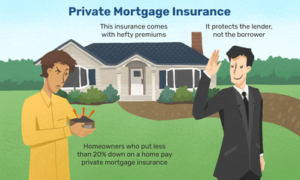If you do need PMI for a conventional mortgage, you’ll choose between four payment methods.
1. Borrower-paid mortgage insurance
Borrower-paid mortgage insurance is the most common type of PMI. With this payment option, you as the borrower make PMI payments.
With BPMI, you’ll make monthly payments. You can roll PMI payments into your mortgage or pay separately each month.
You may contact the lender once you have gained 20% equity in your home to ask to cancel PMI, but the lender isn’t guaranteed to approve this request. Even if your request is denied, the lender is legally required to cancel PMI once you’ve obtained 22% equity in your home.
You can also refinance to get rid of PMI. But to refinance, you’ll have to pay closing costs all over again — so check whether it would save you more money to refinance or to continue paying PMI until you gain more equity.
The downside of BPMI is higher monthly payments. The upsides are that you don’t have to pay for PMI all at once, and you have the ability to cancel payments down the road.
2. Single-premium mortgage insurance
Borrower-paid mortgage insurance requires you to spread out PMI payments monthly, but single-premium mortgage insurance has you pay for PMI in one lump sum.
You might end up paying for SPMI yourself, or you may be able to negotiate for the seller to cover SPMI as part of your offer.
SPMI results in lower monthly payments, but it costs you more upfront. And if you don’t have enough money for a 20% down payment, then you might not have enough for SPMI.
You could also lose money if you sell or refinance before gaining 20% equity in your home. You’ve already paid the amount in full, so you can’t get any of that money back.
SPMI may be best for homebuyers who either can negotiate for the seller to pay, or who plan to stay in the home for a long time without refinancing.
3. Split-premium mortgage insurance
Split-premium mortgage insurance is a combination of SPMI and BPMI. You pay some of the PMI costs at closing, then split the rest up into monthly payments, like you would with BPMI.
This way, you pay less per month than you would with BPMI, and less at closing than with SPMI. You may be able to negotiate that the seller pays your upfront portion, and you can cancel the portion you pay monthly once you’ve gained more equity.
If the seller won’t cover your upfront PMI costs, then split-premium mortgage insurance might not be the best deal. You could put more money toward a down payment rather than toward upfront PMI costs.
4. Lender-paid mortgage insurance
With lender-paid mortgage insurance, the lender actually pays for PMI, not you.
This may sound like a total steal, but there’s a reason LPMI isn’t the most popular type of PMI. The lender pays for your insurance, but it offsets the cost by charging you a higher interest rate. You’re basically still paying for PMI over time by paying more in interest.
The upside of LPI is that your monthly payments will be lower. The downside is that you can’t cancel PMI once you gain enough equity in your home, because the LPMI is part of the mortgage.
PMI typically costs between 0.2% and 2% of your mortgage amount, according to insurance-comparison website Policygenius. Here are some factors that will affect your PMI costs:
- Loan term length. The shorter your term length, the higher your monthly payments will be — so the sooner you’ll reach 20% equity in your home.
- Loan-to-value ratio. The LTV ratio is the amount you borrow for your home related to how much your home is worth. If your LTV is 80% (meaning you have a 20% down payment), then you won’t need PMI at all. The higher your LTV ratio, the more you’ll pay in PMI.
- Credit score. The higher your credit score, the better deal you can get on PMI. The minimum credit score to get a conventional loan is 620, but if your score is higher, then it could help you pay less in PMI.
To lower PMI costs, consider saving more for a down payment or working to increase your credit score before you buy a home.


